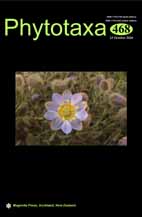Abstract
Aloe marlothii Berger (1905: 87) (Asphodelaceae subfam. Alooideae) (Fig. 1), a single-stemmed, tree-like aloe, occurs widespread in northeastern South Africa and adjacent parts of Botswana, for example near Lobatse in the southeast of the country from where it was originally described (Fig. 2), Zimbabwe, and Mozambique (see maps in Klopper & Smith 2010: 92, Fig. 32 and Van Wyk & Smith 2014: 68). Wherever A. marlothii co-occurs with other species of Aloe Linnaeus (1753: 319), hybrids are produced (Reynolds 1950, Smith & Figueiredo 2015). Aloe globuligemma Pole-Evans (1915: 30, Plates X [Figs 1 and 2] and XI [Figs 1, 2, and 3]) (Fig. 3), a stemless, medium-sized aloe, is restricted to the more subtropical parts of northeastern South Africa, southern Zimbabwe, and Mozambique (see map in Van Wyk & Smith 2014: 158). Where these two species, A. globuligemma and A. marlothii, co-occur, for example at Lebowakgomo, about 50 km southeast of Polokwane, the capital of South Africa’s Limpopo province, a bewildering range of striking hybrids with considerable horticultural potential are found (Reynolds 1950: 446, 484, Retief 2018). This hybrid also occurs a bit further south of the Lebowakgomo location, as well as elsewhere in the Limpopo province, in Sekhukhuneland in the vicinity of Steelpoort and Ohrigstad.

